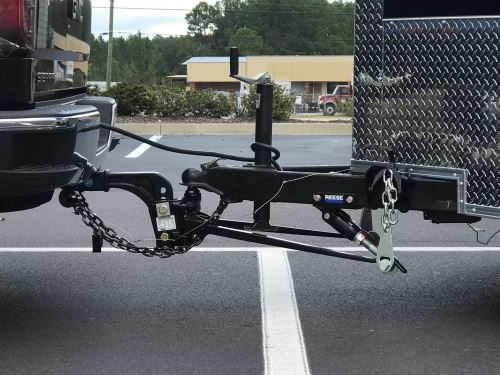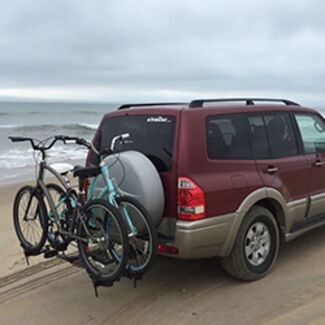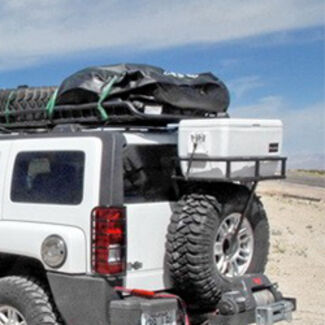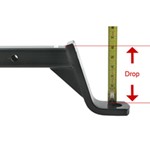
Types of Trailer Hitches: When and why to use each
Rear Receiver Hitch - A general usage hitch that can attach to the back of most vehicles and tow anything from cargo carriers and bike racks all the way to trailers or campers Weight Distribution Hitch - A special attachment to a rear receiver hitch that allows it to tow heavier items more safely and securely. Front Mount Hitch - A hitch that attaches to the front of a vehicle to mount things like plows or winches Fifth Wheel Hitch - A heavy-duty in-bed hitch designed to tow fifth wheel campers Gooseneck Hitch - A primarily industrial/commercial in-bed hitch that can tow large flatbed and livestock trailers designed to be compatible with it Pintle Hitch - A hitch that uses a unique design to tow extremely large items, used almost exclusively in commercial, agricultural, and industrial environments Bumper Hitch - A hitch that attaches directly to the bumper of your vehicle for light items (make sure your bumper is able to handle weight before applying!) Articulating Hitch - A hitch that attaches to the rear of your vehicle, and allows your trailer and towing vehicle to move independently of one another
How Do I Know What Trailer Hitch I Need? (And a Word of Caution)
Rear Receiver Hitch
Cars Trucks Vans SUVs
Bike Racks Cargo Carriers Trailers/Campers



Weight Distribution Hitch
Trucks Large SUVs
Large travel trailers Anything weighing more than 50% of the towing vehicle's weight


Front Mount Hitch
Trucks SUVs
Winches Snow plows Spare tire mounts Bike Racks


Fifth-Wheel Hitch
Large trucks
Fifth wheel campers


Gooseneck Hitch
Large trucks
Large flatbed trailers Livestock trailers Horse trailers





Pintle Hitch
Commercial trucks Large industrial vehicles
Large commercial trailers Industrial hauling
Bumper Hitch
Campers or RVs without a rear receiver hitch
Bike racks Cargo carriers




Off-roading vehicles that are taking their trailer for a bumpy ride
Overlanding trailers Teardrop campers

Last Updated: 7/25/2024

Mike
2/2/2023
On the eTrailer website, it is stated that a gooseneck adapter (NOT the Goosebox) is only for very limited or even one time short usage, and also the frame warranty (usually Lippert) will be voided if there is any frame damage due to this usage. On the other hand, the Goosebox is the only gooseneck type hitch approved by Lippert and will NOT void the frame warranty. In addition, there are 260 reviews (5 star average) on eTrailer for the Goosebox and I could not find a single complaint or comment regarding reduced stability compared to a traditional pinbox and 5th wheel hitch. So if there is any differences regarding stability, either nobody notices or it just doesn't exist.

Mike
1/27/2023
Generally agree with this info, however I would take exception to the statement "The gooseneck hitch doesn’t do as well handling particularly tall trailers or campers, as they offer less stability than a fifth wheel hitch." I tow my 15k Montana with a 1 dually Ram and a B&W Turnover ball with a Reese 20k Goosebox. I can assure you that it is quite stable! Gooseneck adapters are to be avoided for 5th wheel use. I would argue that a proper gooseneck setup (like mine) has an advantage from a stability standpoint in the the weight of the 5th wheel (pin weight) in attached to the truck down much lower in the bed...essentially right on the frame.




James
1/27/2023
You did not mention articulating hitches for use pulling camping trailers off-road

Departments
Towing
- Trailer Hitch
- Fifth Wheel
- Gooseneck
- Towing a Vehicle
- Front Hitch
- RV Hitch
- ATV Hitch
- HD Truck Hitch
- Vehicle Wiring
- Brake Controller
- Ball Mounts
- Weight Distribution
Sports and Recreation
Trailer Parts
- Utility Trailer
- Boat Trailer
- Landscape Trailer
- Enclosed Trailer
- 5th/Camper Trailer
- Car Hauler
- Horse Trailer
Vehicle
Contact & Help

What our customers are saying:
"WOW! I compared prices with a local dealer and saved $85 over 25% on my purchase and had it delivered to my door."

































Meshach
7/31/2024
We have a flatbed with what looks like in the bed a male king pin welded into bed. Flat on top notch all around. Is that a king pin? How or what do we use to adapt to a goose neck that uses a ball on a bed?